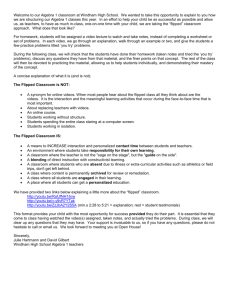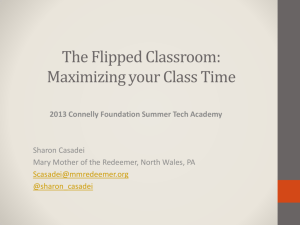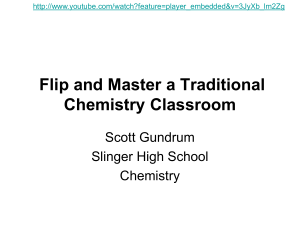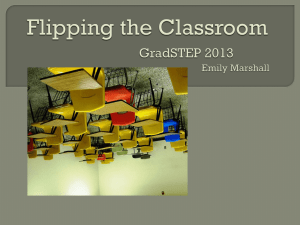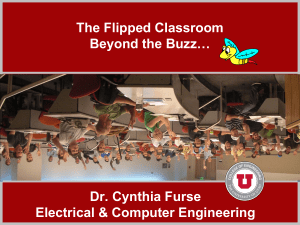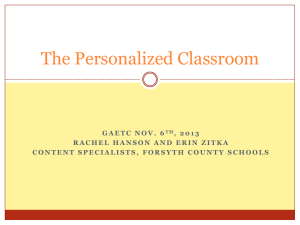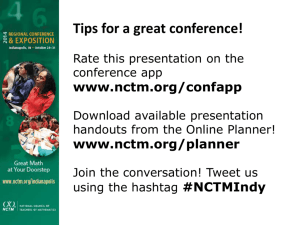Flipping or Mastery
advertisement
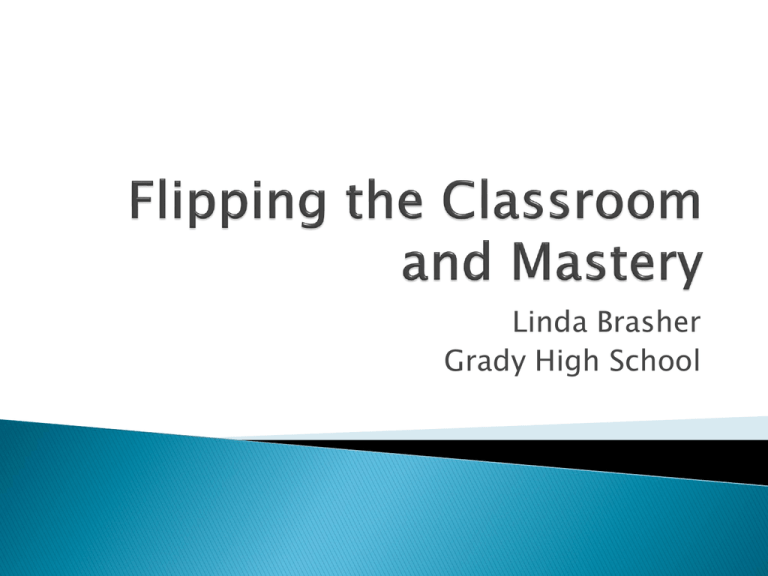
Linda Brasher Grady High School Conference Attended Great Idea I can do this - (I’m crazy busy and not very technology savvy) Jonathan Bergmann and Aaron Sams The traditional definition of a flipped class is: ◦ Where videos take the place of direct instruction ◦ This then allows students to get individual time in class to work with their teacher on key learning activities. ◦ It is called the flipped class because what used to be classwork (the "lecture" is done at home via teacher-created videos and what used to be homework (assigned problems) is now done in class. A synonym for online videos. When most people hear about the flipped class all they think about are the videos. It is the the interaction and the meaningful learning activities that occur during the face-toface time that is most important. About replacing teachers with videos. An online course. Students working without structure. Students spending the entire class staring at a computer screen. Students working in isolation. A means to INCREASE interaction and personalized contact time between students and teachers. An environment where students take responsibility for their own learning. A classroom where the teacher is not the "sage on the stage", but the "guide on the side". A blending of direct instruction with constructivist learning. A classroom where students who are absent due to illness or extra-curricular activities such as athletics or field-trips, don't get left behind. A class where content is permanently archived for review or remediation. A class where all students are engaged in their learning. A place where all students can get a personalized education. Students don’t receive zeros for missed work. Any and every assignment given can be turned in for full credit. No more skipping out on content because of missing work. Students receive weekly grades instead of grades for each piece of work they complete. Students direct their own learning…including taking “educational tangents” into areas of interest within each unit of study. Students are not allowed to move on to the next unit of study until they demonstrate mastery of the current unit via some form of assessment. Pros High retention rates Higher test performance Higher student course evaluations Higher student confidence Cons Heavy teacher workload Administrative difficulties tracking student progress Varying teacher freedom of instruction I teach Inner City Low Scio-Economic (Title I School) Enrollment 1398 Math Common Core ◦ ◦ ◦ ◦ Coordinate Algebra Coordinate Algebra Support Accelerated Coordinate Algebra/Geometry Accelerated Math 2 Inclusion Classes Isolation For students to watch instructional videos for homework Allow class time to work on real-world application problems, projects, hands-on Allow More Teacher to Student and Student to Student Interaction Students will work on problems until they master Standard Post-Assessments given at the end of each lesson. No Late Work No Make-up Work No Gap In Learning When Teacher is Out Students Responsible for Their Own Learning Reduce Failure Rate Allow Differentiation for All Students (mini lectures) ◦ Special Education ◦ Gifted ◦ Advanced Student to Move to Accelerated School Electronic Policy Students without Internet Classwork/Homework Enrichment Activities Standards Assessment 20% 20% 60% What you need: Writing Tablet Recording Software Camtasia ($179 for educators – 30 day Free Trial) ScreenFlow (Mac Only - $99 30 Day Free Trial) CamStudio (PC Only Free) Jing (Free) Screen-O-Matic (Free 15 minute Videos -$15 year for unlimited and editing) ◦ Screen Flow ◦ ◦ ◦ ◦ ◦ ScribbleScreen (Free Mac and PC) ◦ Microphone ◦ Webcam Edmodo (no space limit) YouTube (Initial time 15 minute limit) Screencast.com (2GB storage) Vimeo (500MB/week) Google Site Moodle Wikispaces/Blogs Make PowerPoint Upload to Active Inspire Record Upload on Edmodo Most Lessons about 20 minutes School Electronic Policy ◦ Administration Allowed B.Y.O.T Students without Internet ◦ Burn CD’s or DVD’s Flipped Classroom is Easy Mastery is Complicated Regular Classes/Inclusion Classes Students not doing the work No concept of time management Not working for understanding Moving to Slow A/B Block Still Teacher Directed Not Showing Mastery Accelerated Classes Working Great All students performing well More advanced – give more enrichment activities Follow Along Note Packet (Beginning of each Unit) Lecture notes, Worksheets, References Assignment vs. Objective based grading Prove they know it Student Defined Focus on Formative assessment for grading One-on-one discussion Intentional, directed questioning Group work/Peer tutoring Instant Feedback Moodle something that builds a test bank Set Grade Levels A = Pass Unit 5 Exam (85% or better) B = Unit 5 Podcast 5.3 C = Pass Unit 4 Exam (85% or better) F = anything than less than above. Unit Objectives http://www.pr2ta.com/content/academicprogram/graduation-requirements/ Start with Flipping or Mastery Next implement the other Research and adapt to your personality Get out and observe The Flipped Classroom has its own learning organization http://flippedclassroom.org/ Bergmann and Sams website: https://flippedlearning.eduvision.tv/default.aspx The Flipped Class Manifest http://www.thedailyriff.com/articles/how-the-flippedclassroom-is-radically-transforming-learning-536.php The Blended Classroom – Master Learning at Work http://blendedclassroom.blogspot.com/ ◦ http://www.thedailyriff.com/articles/the-flipped-class-manifest-823.php The Educator’s PLN http://www.edupln.com/ Educational Technology Network http://www.edtechnetwork.com/podcasting_vod casting.html The Flipped Class Blog http://blendedclassroom.blogspot.com/ Book Flip your Classroom http://www.iste.org/store/product?ID=2285


